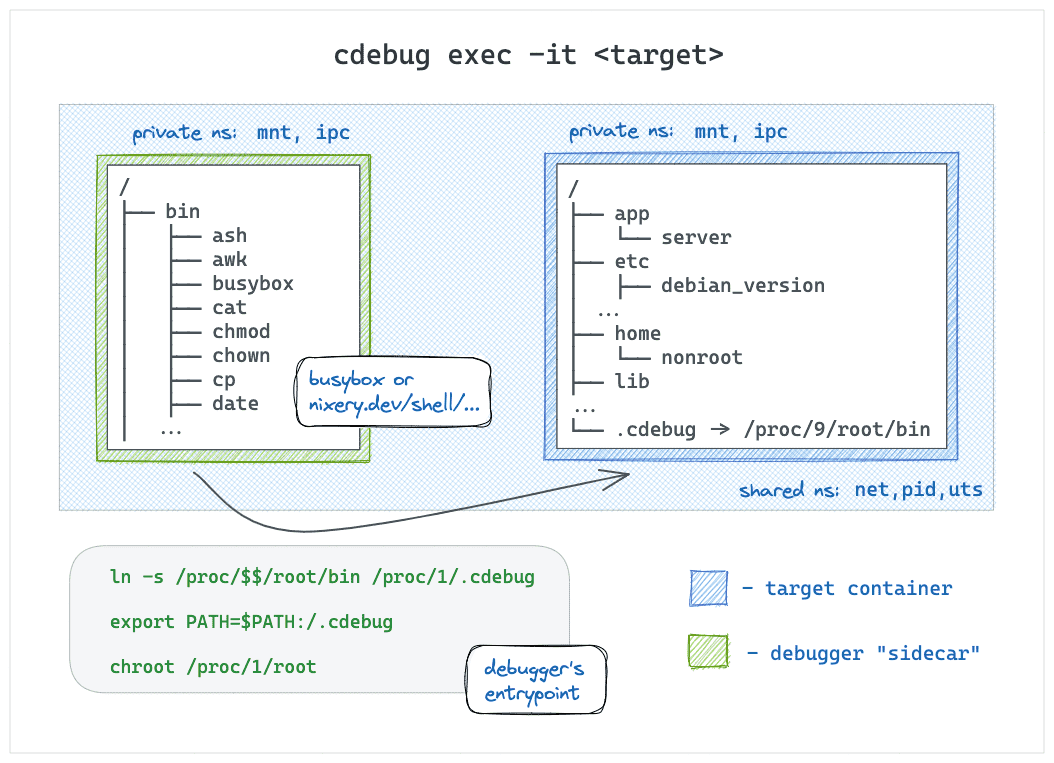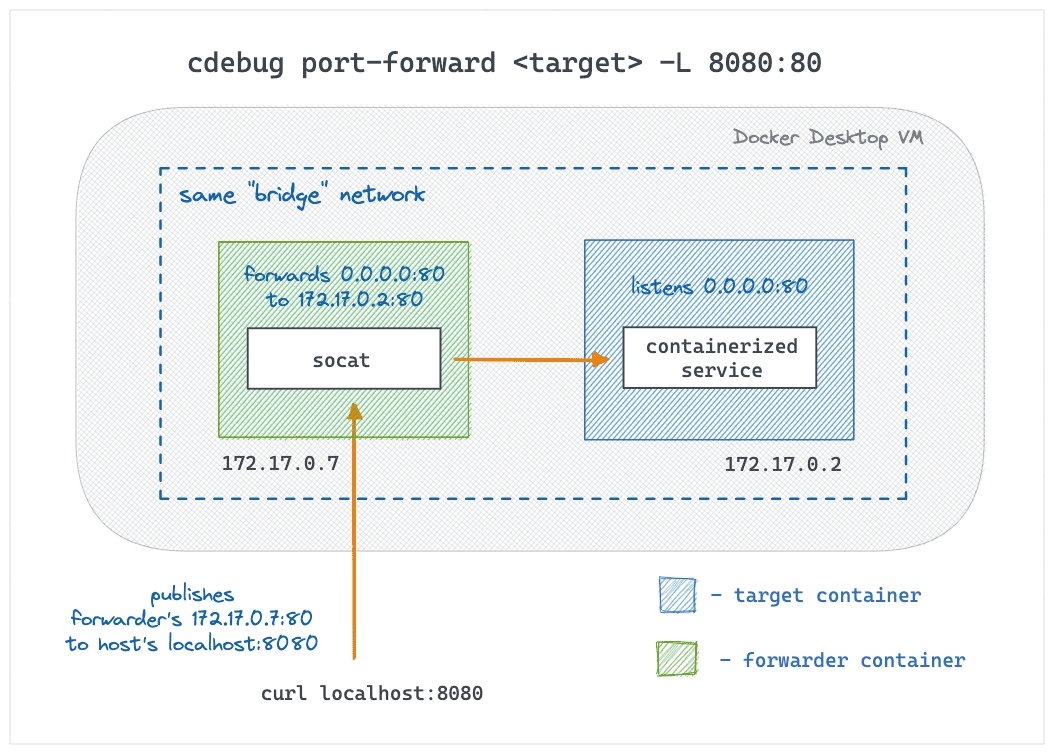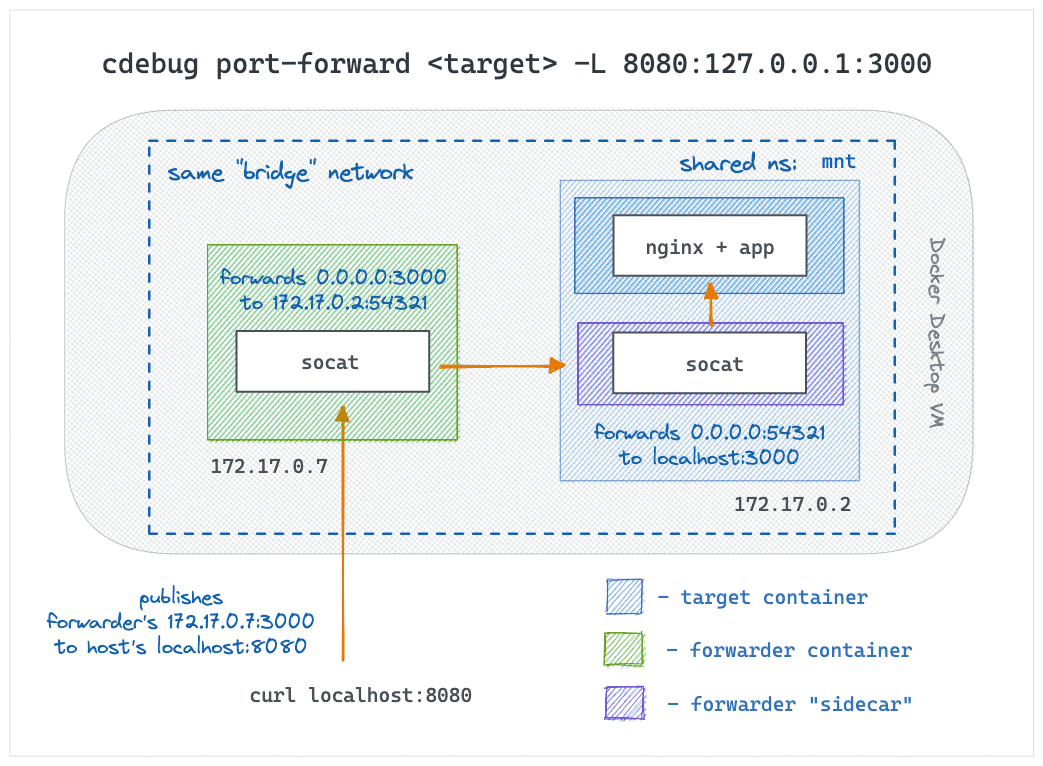! Support development of this project > patreon.com/iximiuzWith this tool you can:
- Troubleshoot containers and pods lacking shell and/or debugging tools.
- Forward unpublished or even localhost ports to your host system.
- Expose endpoints from the host system to containers & Kubernetes networks.
- Handily export image's and/or container's filesystem to local folders.
- and more :)
The following commands x runtimes are supported:
| Docker | Podman | containerd | OCI (runc, crun) | Kubernetes | CRI | |
|---|---|---|---|---|---|---|
exec |
✅ | - | ✅ | - | ✅ | - |
port-forward local |
✅ | - | - | - | - | - |
port-forward remote |
🛠️ | - | - | - | - | - |
export |
- | - | - | - | - | - |
It's a statically linked Go binary, so you know the drill:
GOOS=linux
GOARCH=amd64
curl -Ls https://github.com/iximiuz/cdebug/releases/latest/download/cdebug_${GOOS}_${GOARCH}.tar.gz | tar xvz
sudo mv cdebug /usr/local/binIf you're a Homebrew user, you can install the tool via brew on macOS or Linux:
$ brew install cdebugAt the moment, the following systems are (kinda sorta) supported:
- linux/amd64
- darwin/amd64
- darwin/arm64
Execute commands or start interactive shells in scratch, slim, or distroless containers, with ease:
# Start a busybox:musl shell in the Docker container:
cdebug exec -it mycontainer
cdebug exec -it docker://mycontainer
# Execute a command in the Docker container:
cdebug exec mycontainer cat /etc/os-release
# Use a different debugging toolkit image:
cdebug exec -it --image=alpine mycontainer
# Use a nixery.dev image (https://nixery.dev/):
cdebug exec -it --image=nixery.dev/shell/vim/ps/tshark mycontainer
# Exec into a containerd container:
cdebug exec -it containerd://mycontainer ...
cdebug exec --namespace myns -it containerd://mycontainer ...
# Exec into a nerdctl container:
cdebug exec -it nerdctl://mycontainer ...
# Start a shell in a Kubernetes pod:
cdebug exec -it pod/mypod
cdebug exec -it k8s://mypod
cdebug exec --namespace=myns -it pod/mypod
# Start a shell in a Kubernetes pod's container:
cdebug exec -it pod/mypod/mycontainerThe cdebug exec command is a crossbreeding of docker exec and kubectl debug commands.
You point the tool at a running container, say what toolkit image to use, and it starts
a debugging "sidecar" container that feels like a docker exec session to the target container:
- The root filesystem of the debugger is the root filesystem of the target container.
- The target container isn't recreated and/or restarted.
- No extra volumes or copying of debugging tools is needed.
- The debugging tools are available in the target container.
By default, the busybox:musl (statically compiled) image is used for the debugger sidecar, but you can override it
with the --image flag. Combining this with the superpower of Nix and Nixery,
you can get all your favorite tools by simply listing them in the image name:
cdebug exec -it --image nixery.dev/shell/ps/vim/tshark <target-container>
How it works
The technique is based on the ideas from this blog post.
Oversimplifying, the debugger container is started like:
docker run [-it] \
--network container:<target> \
--pid container:<target> \
--uts container:<target> \
<toolkit-image>
sh -c <<EOF
ln -s /proc/$$/root/bin/ /proc/1/root/.cdebug
export PATH=$PATH:/.cdebug
chroot /proc/1/root sh
EOFThe secret sauce is the symlink + PATH modification + chroot-ing.
Forward local ports to containers and vice versa. This command is another crossbreeding -
this time it's kubectl port-forward and ssh -L|-R.
Currently, only local port forwarding (cdebug port-forward -L) is supported,
but remote port forwarding is under active development.
Local port forwarding use cases (works for Docker Desktop too!):
- Publish "unpublished" port 80 to a random port on the host:
cdebug port-forward <target> -L 80 - Expose container's localhost to the host system:
cdebug port-forward <target> -L 127.0.0.1:5432 - Proxy local traffic to a remote host via the target:
cdebug port-forward <target> -L <LOCAL_HOST>:<LOCAL_PORT>:<REMOTE_HOST>:<REMOTE_PORT> - 🛠️ Expose a Kubernetes service to the host system:
cdebug port-forward <target> -L 8888:my.svc.cluster.local:443
Remote port forwarding use cases:
- Start a container/Pod forwarding traffic destined to its
<IP>:<port>to a non-cluster endpoint reachable from the host system. - ...
How it works
Local port forwarding is implemented by starting an extra forwarder container in the
target's network and publishing its ports to the host using the standard means (e.g.,
docker run --publish). The forwarder container itself runs something like:
socat TCP-LISTEN:<REMOTE_PORT>,fork TCP-CONNECT:<REMOTE_HOST>:<REMOTE_PORT>
If the REMOTE_HOST doesn't belong to the target or it's the target's localhost,
an extra sidecar container is started in the target's network namespace with another
socat forwarding traffic from the target public interface to REMOTE_HOST:REMOTE_PORT.
Remote port forwarding will use similar tricks but combined with more advanced reverse tunneling.
Below are a few popular scenarios formatted as reproducible demos.
First, a target container is needed. Let's use a distroless nodejs image for that:
$ docker run -d --rm \
--name my-distroless gcr.io/distroless/nodejs \
-e 'setTimeout(() => console.log("Done"), 99999999)'Now, let's start an interactive shell (using busybox) into the above container:
$ cdebug exec -it my-distrolessExploring the filesystem shows that it's a rootfs of the nodejs container:
/ $# ls -lah
total 60K
drwxr-xr-x 1 root root 4.0K Oct 17 23:49 .
drwxr-xr-x 1 root root 4.0K Oct 17 23:49 ..
👉 lrwxrwxrwx 1 root root 18 Oct 17 23:49 .cdebug-c153d669 -> /proc/55/root/bin/
-rwxr-xr-x 1 root root 0 Oct 17 19:49 .dockerenv
drwxr-xr-x 2 root root 4.0K Jan 1 1970 bin
drwxr-xr-x 2 root root 4.0K Jan 1 1970 boot
drwxr-xr-x 5 root root 340 Oct 17 19:49 dev
drwxr-xr-x 1 root root 4.0K Oct 17 19:49 etc
drwxr-xr-x 3 nonroot nonroot 4.0K Jan 1 1970 home
drwxr-xr-x 1 root root 4.0K Jan 1 1970 lib
drwxr-xr-x 2 root root 4.0K Jan 1 1970 lib64
drwxr-xr-x 5 root root 4.0K Jan 1 1970 nodejs
...Notice 👉 above - that's where the debugging tools live:
/ $# echo $PATH
/usr/local/sbin:/usr/local/bin:/usr/sbin:/usr/bin:/sbin:/bin:/.cdebug-c153d669The process tree of the debugger container is the process tree of the target:
/ $# ps auxf
PID USER TIME COMMAND
1 root 0:00 /nodejs/bin/node -e setTimeout(() => console.log("Done"),
13 root 0:00 sh -c set -euo pipefail sleep 999999999 & SANDBOX_PID=$!
19 root 0:00 sleep 999999999
21 root 0:00 sh
28 root 0:00 [sleep]
39 root 0:00 [sleep]
45 root 0:00 ps auxfIf the tools provided by busybox aren't enough, you can bring your own tools with
a little huge help of the nixery project:
$ cdebug exec -it --image nixery.dev/shell/vim my-distrolessEven more powerful exammple:
$ cdebug exec -it --image nixery.dev/shell/ps/findutils/tshark my-distrolessFirst, start the target container:
$ sudo ctr image pull docker.io/library/nginx:latest
$ sudo ctr run -d docker.io/library/nginx:latest nginx-1Run an interactive shell in the target container using simple cdebug exec:
$ sudo cdebug exec -it containerd://nginx-1
/ $# wget -O- 127.0.0.1
Run VIM in the target container using cdebug exec --image nixery.dev/shell/vim:
$ sudo cdebug exec -it --rm --image nixery.dev/shell/vim containerd://nginx-1Start a container using nerdctl:
$ sudo $(which nerdctl) run -d --name nginx-1 nginx
9f8763d82259a6e3e747df83d0ce8b7ee3d33d94269a72cd04e0e3862a3abc5fRun the debugger using the nerdctl:// schema and the target's name:
$ sudo cdebug exec -it --rm nerdctl://nginx-1Or run a debugging session in the above container using the containerd:// schema:
$ sudo cdebug exec -it --rm containerd://9f876Start the target Pod:
$ kubectl run --image nginx:alpine nginx-1
$ kubectl run --image=nginx:alpine nginx-1 \
--overrides='{ "apiVersion": "v1", "spec": { "containers": [{ "name": "app", "image": "nginx:alpine" }] } }'
pod/nginx-1 created
$ kubectl get pods
NAME READY STATUS RESTARTS AGE
nginx-1 1/1 Running 0 5sRun the debugger in the Pod (it'll start a new ephemeral container):
$ cdebug exec -it pod/nginx-1Expected output:
Debugger container name: cdebug-3023d11d
Starting debugger container...
Waiting for debugger container...
Attaching to debugger container...
If you don't see a command prompt, try pressing enter.
/ # ps auxf
PID USER TIME COMMAND
1 root 0:00 sh /.cdebug-entrypoint.sh
10 root 0:00 /bin/sh -i
11 root 0:00 ps auxf
Run the debugger in the Nginx container (app):
$ cdebug exec -it pod/nginx-1/appcdebug exec -it pod/nginx-1/app
Debugger container name: cdebug-b44ca485
Starting debugger container...
Waiting for debugger container...
Attaching to debugger container...
If you don't see a command prompt, try pressing enter.
/ # ps auxf
PID USER TIME COMMAND
1 root 0:00 nginx: master process nginx -g daemon off;
30 nginx 0:00 nginx: worker process
...
41 nginx 0:00 nginx: worker process
42 root 0:00 sh /.cdebug-entrypoint.sh
51 root 0:00 /bin/ash -i
52 root 0:00 ps auxf
Currently, only containerd CRI is supported. First, you'll need to list the running containers:
$ ctr -n k8s.io container ls
CONTAINER IMAGE RUNTIME
155227c0e9aa8 k8s.gcr.io/pause:3.5 io.containerd.runc.v2
2220eacd9cb26 registry.k8s.io/kube-apiserver:v1.25.3 io.containerd.runc.v2
22efcb35a651a registry.k8s.io/etcd:3.5.4-0 io.containerd.runc.v2
28e06cc63b822 docker.io/calico/cni:v3.24.1 io.containerd.runc.v2
30754c8492f18 docker.io/calico/node:v3.24.1 io.containerd.runc.v2
61acdb0231516 docker.io/calico/kube-controllers:v3.24.1 io.containerd.runc.v2
...Now you can exec into a Pod's container bringing your own debugging tools:
$ cdebug exec -n k8s.io -it --rm containerd://2220eaStart an nginx container but don't expose its port 80:
$ docker run -d --name nginx-1 nginx:1.23Forward local port 8080 to the nginx's 80:
$ cdebug port-forward nginx-1 -L 8080:80
$ curl localhost:8080Start a containerized service that listens only on its localhost:
$ docker run -d --name svc-1 python:3-alpine python3 -m 'http.server' -b 127.0.0.1 8888Tap into the above service:
$ cdebug port-forward svc-1 -L 127.0.0.1:8888
Pulling forwarder image...
latest: Pulling from shell/socat
Digest: sha256:b43b6cf8d22615616b13c744b8ff525f5f6c0ca6c11b37fa3832a951ebb3c20c
Status: Image is up to date for nixery.dev/shell/socat:latest
Forwarding 127.0.0.1:49176 to 127.0.0.1:8888 through 172.17.0.4:34128
$ curl localhost:49176
<!DOCTYPE HTML>
<html lang="en">
<head>
...Q: Running cdebug exec fails with rm: cannot remove '/proc/1/root/nix': Permission denied or
ln: /proc/1/root/.cdebug-XXXXXXXX: Permission denied.
Chances are your target container has been started with elevated permissions while you're trying to run a non-privileged debugger sidecar.
Try cdebug exec --privileged instead.
-
slim debug- adebugcommand for Slim(toolkit) (originally contributed by D4N) -
debug-ctr- a debugger that creates a new container out of the original container with the toolkit mounted in a volume (by Felipe Cruz Martinez) -
docker-debug- much likecdebug execbut without the chroot trick. -
docker-opener- a multi-purpose tool that in particular can run a shell session into your container (and if there is no shell inside, it'll bring its own busybox). -
cntr- is "a replacement fordocker execthat brings all your developers tools with you" by mounting the file system from one container (or the host) into the target container and creating a nested container with the help of a FUSE filesystem. Supports a huge range of runtimes (docker, podman, LXC/LXD, rkt, systemd-nspawn, containerd) because it operates on the OS level. -
kdiag- a kubectl plugin to get shell access to scratch containers, stream logs from multiple pods simultaneously, and do reverse port forwarding to Kubernetes clusters. -
kpexec- a CLI that runs commands in a Kubernetes container with high privileges (via a privileged Pod with Node access).
- More
execflags (like indocker run):--cap-add,--cap-drop,--env,--volume, etc. - Helper command(s) suggesting nix(ery) packages
- Non-docker runtimes (Podman, CRI, OCI)
- More E2E Tests
It's a pre-alpha with no sound design yet, so I may not be accepting all PRs. Sorry about that :)


